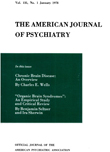GENETIC AND ENVIRONMENTAL FACTORS IN PSYCHOSES OF CHILDREN
Abstract
1. The predominance of unfavorable hereditary tendencies in the parents of the psychotic children was emphasized by the fact that there was a large number of abnormal siblings in this group.
2. A most striking revelation was the total lack of security in the human relationships to which the psychotic children were subjected. It is appalling to note the disturbed home life, the beatings and the brutal treatment these children received, and the hatred many of them bore toward their parents. There were many abnormal attachments to parents or parent substitutes, which kept the children immature, repressed, dependent and insecure in their social relationships. The perfectionist parents set up standards too high for their children to attain, and here we found the children in conflict because of feelings of guilt and inadequacy.
3. The insecurity of the psychotic group was further evidenced by the large number of destitute homes, inferior neighborhoods, and placements in focter homes and institutions. Low economic status prevented the children from having even the necessities of life and opportunities productive of normal development. The burden that the families of the psychotic children imposed on the community was emphasized by the fact that 45 of them had 326 registrations with social agencies, an average of 7 per family. This was in marked contrast to the control group in which 14 families had 16 registrations chiefly for assistance during the years of depression.
4. In the matter of health, we found that adverse prenatal factors were outstanding in the psychotic group, whereas the number of instrumental and difficult births were about equal in both groups. No doubt, the higher economic and social standards in the control group made better medical and surgical care available to these children at the time of birth and throughout childhood. This advantage may also account for the less damaging effects of the serious illnesses that occurred in rather large numbers in the control group.
5. The conflicts seen in the psychotic children centered around their violent personal relationships and sex experiences. The conflicts in the control group were chiefly concerned with school difficulties and social striving.
6. Psychic traumas contributed significantly to the mental breakdown of a large number of psychotic children. Ten of them had been shocked by the deaths of parents to whom they had retained infantile attachments. Four children were so disoriented upon learning of their adoption that they could not reconcile themselves to the true situation. Four children had lived with mentally ill mothers who were finally hospitalized. Sex traumas were reported in 14 cases of children who were overwhelmed with guilt and fear regarding masturbation. Four boys had been seduced and exploited by homosexuals. Three children were horrified by incest in the home, and 3 girls had become pregnant. Five girls were obsessed with imaginary pregnancy, having had no sex instruction except from their associates. Six children had been tormented, beaten, tied and confined by their companions so that they were terrified in the company of children, and felt safe only with adults. Two children of the control group had had similar experiences but the situations had been handled wisely.
7. The children in the control group by contrast had for the most part led happy, active and well-organized lives. In addition to school work and related activities, there were many club and other social affiliations. Most of the children had hobbies, and a number were on the editorial staffs of their school papers. Twenty boys and 14 girls were earning money outside the home. Sixteen boys were about to enter the military service, and 7 girls were helping in war activities. A large number of the children had church affiliations, and a number were active in church work. The few shy and unsocial children were gaining satisfaction by being on the honor rolls, by developing musical and artistic abilities, and by devotion to family
In conclusion, it can be said without qualification that children have the right to expect of their homes and of society the same privileges that we, as adults, demand in our lives; namely, security, justice, love and opportunity. We can readily appreciate that the psychotic children have been tragically defrauded, while the children in the control group have had their share of privileges. It is, therefore, the responsibility of all persons engaged in mental health work to see to it that children are given their rightful opportunities so that we may look forward to a reduction in the number of cases presenting symptoms of mental and nervous disorders.
Access content
To read the fulltext, please use one of the options below to sign in or purchase access.- Personal login
- Institutional Login
- Sign in via OpenAthens
- Register for access
-
Please login/register if you wish to pair your device and check access availability.
Not a subscriber?
PsychiatryOnline subscription options offer access to the DSM-5 library, books, journals, CME, and patient resources. This all-in-one virtual library provides psychiatrists and mental health professionals with key resources for diagnosis, treatment, research, and professional development.
Need more help? PsychiatryOnline Customer Service may be reached by emailing [email protected] or by calling 800-368-5777 (in the U.S.) or 703-907-7322 (outside the U.S.).



